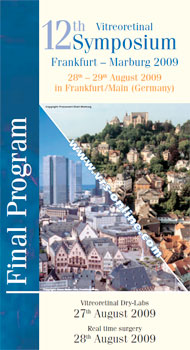12th Vitreoretinal Symposium Frankfurt – Marburg 2009
Scientific programm: Abstract
Poster
50. Sparing Vitreoretinal Surgery for
Proliferative Diabetic Vitreoretinopathy
Michael M. Shishkin, N. N. Safarli (Moscow)
The advent of pars plana vitrectomy by Robert Machemer [1995] considerably improved the prognosis of advanced stages of diabetic retinopathy. So-called minimal invasive surgery reflects a new trend in vitreoretinal surgery. According to the slogan: “maximize the efficiency by saving operating time and inducing less surgically induced trauma”, a variety of techniques are under investigation in nowadays. Despite improved techniques, the surgical prognosis is lagging behind patient expectations, especially in cases of advanced proliferative stages.
We describe our experiences with sparing and delicate approaches compared with tradition vitreoretinal surgery for removing of fibrovascular membrane or proliferative tissue. Although some risk factors for diabetic retinopathy have been determined, the exact pathogenesis is yet unknown. Our clinical observations shows that vitreoretinal traction plays a key role in the pathogenesis of proliferative diabetic vitreoretinophaty (PDVR)
Objective: The goal of this study was to compare and evaluate long-term results of sparing and traditional vitreoretinal surgery for PDVR.
Methods: 62 eyes of 49 patients with fibrovascular proliferation in advanced diabetic retinopathy performed by vitrectomy from 2006 to 2009 were analyzed. All patients had a complete ophthalmic examination preoperatively. Indications for surgery were: vitreous hemorrhage, vitreous hemorrhage & tractional retinal detachment and combined tractional-rhegmatogenous retinal detachment. We used our modified (sparing) surgical technique in 44 eyes (36 patients) and the traditional vitreous surgery technique in 18 eyes ( 13 patients). Patients were operated on by the same surgeon (S.M.M.). In the group that received the sparing surgical technique all surgical procedures were performed under local anesthesia, whereas the tradition technique was performed under general anesthesia. During sparing surgery we carefully performed membrane dissection techniques (segmentation and delamination) for removing of fibrovascular membrane where it had low adherence to the retina., We also avoided totally removing the membrane and en bloc membranectomy techniques when fibrovascular membrane or proliferation tissue was highly adherent to the retina; in these instances we retained the rest of proliferative membrane in eyes. Consequently greatly reducing the likelihood of damage to the retina with the instruments.
The intraoperative and postoperative complications (retinal redetachments, iatrogenic breaks, hemorrhages, secondary glaucoma and visual improvement) were compared in both groups.
Results: Sparing vitreoretinal surgery showed a lower incidence of intraoperative and postoperative iatrogenic breaks than traditional vitreous surgery. There were significant differences in the rate of postoperative complication and visual improvement between both techniques. The mean duration of surgery was notably shorter in the sparing surgical technique than in the tradition approach, and all patients who received the sparing technique reported minimal discomfort during the procedure. We have not observed any postoperative reproliferation of fibrovascular membrane or proliferative tissue (which was not fully removed and remained in operated eyes after sparing vitrectomy) in the group treated with the sparing technique (follow-up range 6 to 28 month).
Conclusion: In summary our findings suggest that- vitreoretinal traction (the static and dynamic tractional forces, mechanical and tractional stess) - may be an important and a leading factor in the pathogenesis of progressive fibrovascular proliferations of PDVR. Our well-founded and reliable sparing vitreoretinal approach offers the advantages of quicker and minimally invasive surgery with faster - visual and somatic rehabilitation. In addition it offers the advantages of less -surgical stress, shorter duration of surgery and reduced incidence of postoperative complication in diabetic patients. Because of its simplicity and the short duration of surgery, the procedure can be performed under local anesthesia.
Copyright © VRS-online, 1999-.
All rights reserved. Impressum, rechtliche Hinweise
HTML & Webdesign: SPALLEK.COM
